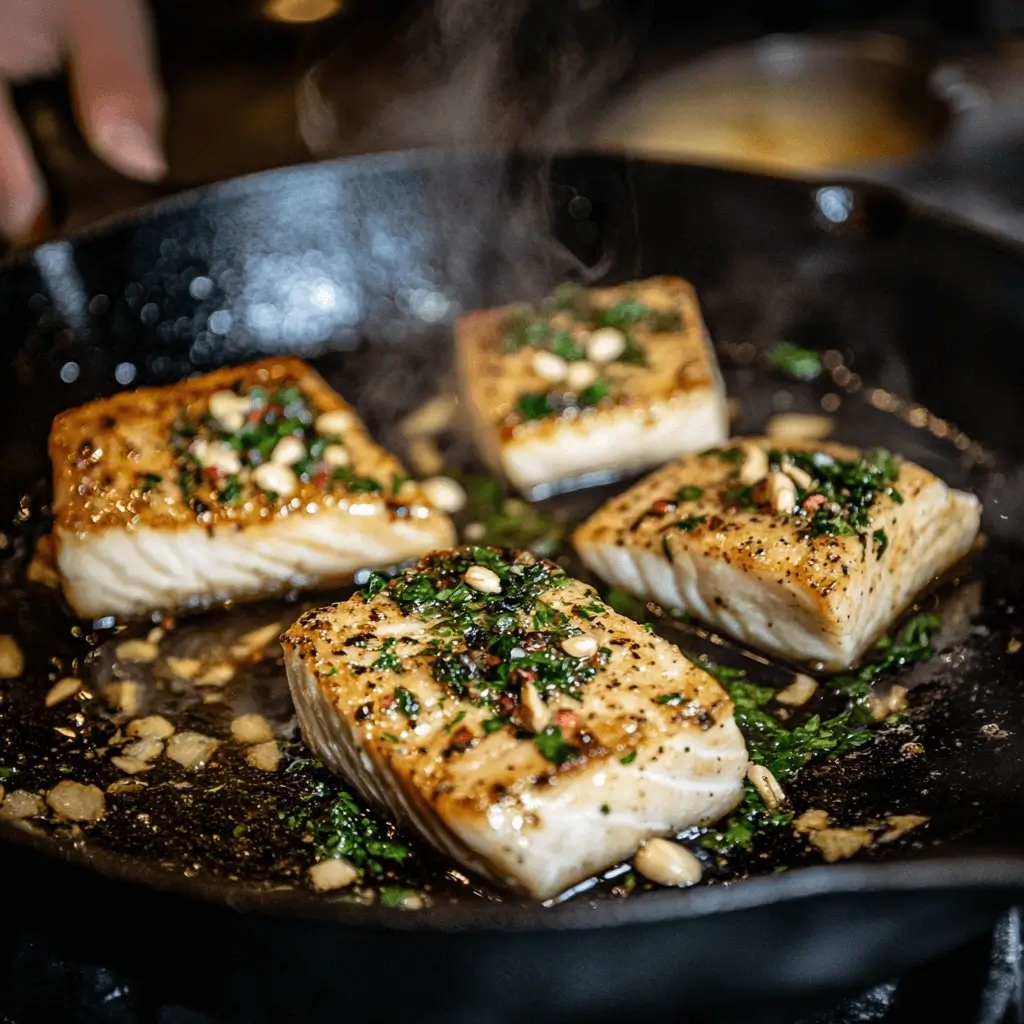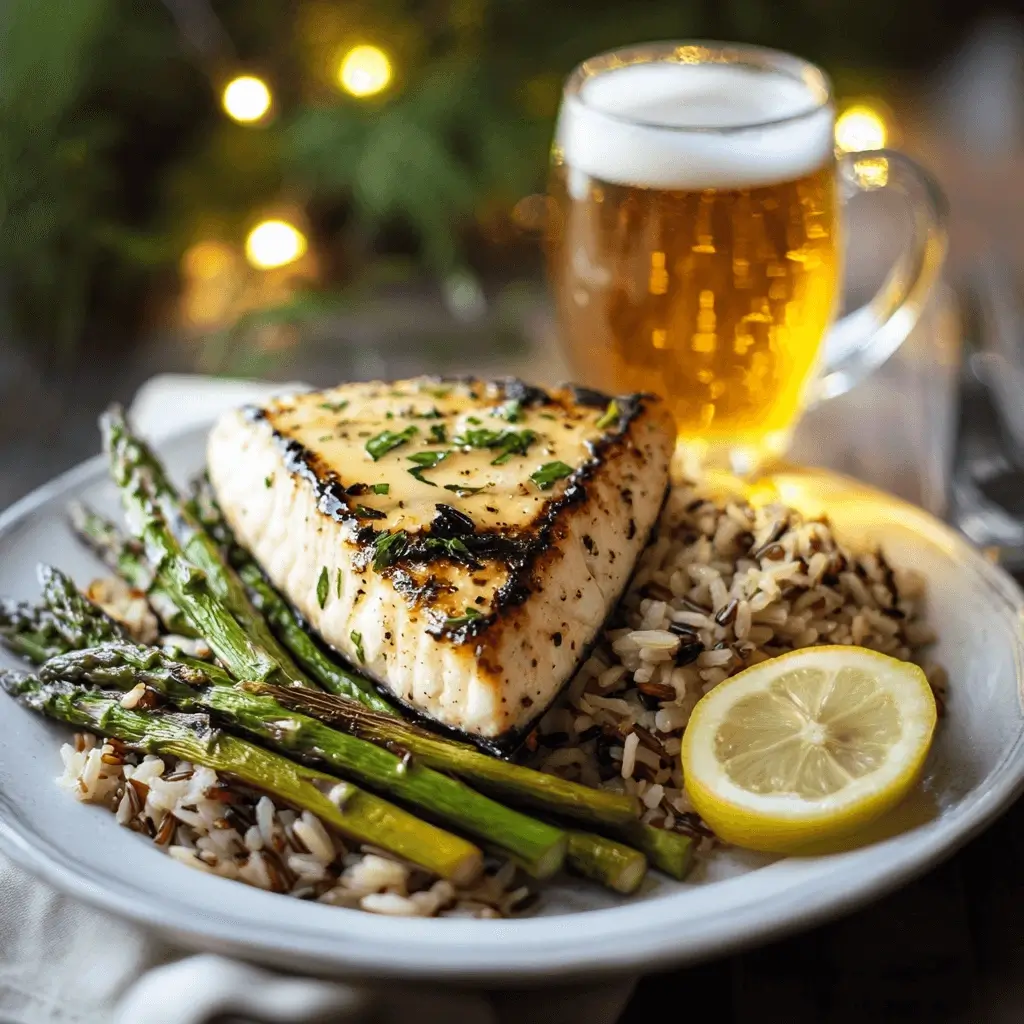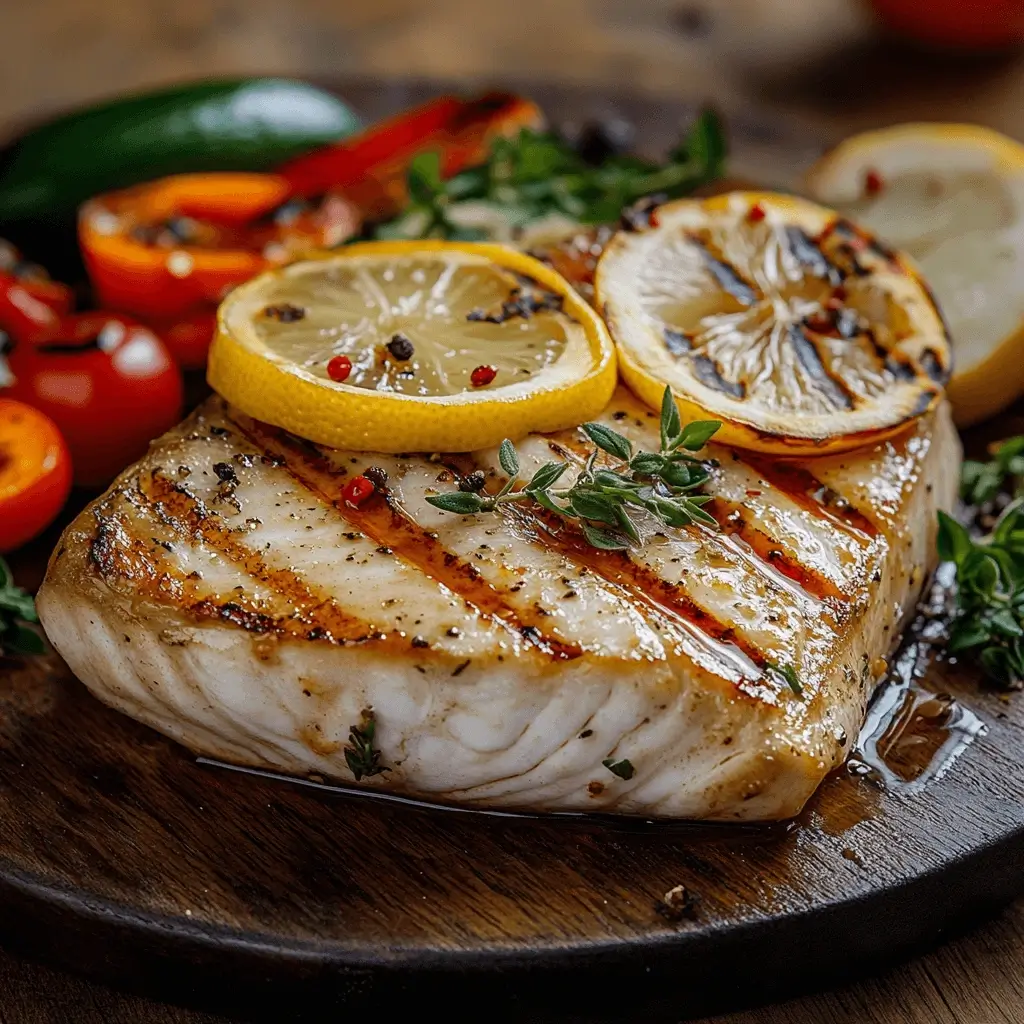Introduction
If you’ve ever stood at the seafood counter staring at a thick, meaty swordfish steak and thought, “How the heck do I cook this thing?” — you’re not alone. But here’s the secret: swordfish is one of the easiest and most rewarding fish to cook, even for beginners. This post will share an amazing swordfish recipe you can try at home.
With its firm texture and mild flavor, swordfish is the perfect “gateway fish” for folks who usually lean toward steak or chicken. Whether you’re searing it in a hot pan, throwing it on the grill, or baking it with lemon and herbs, this fish can take the heat — literally. And the best part? It’s done in under 15 minutes.
In this post, you’ll learn how to cook swordfish using simple techniques and everyday ingredients. We’ll cover everything from choosing the right cut to pairing it with the perfect side (and beer!). Ready to turn that seafood steak into a stunning dinner? Let’s dive in.
Why Swordfish is Perfect for Easy, Delicious Meals
If you’re on the hunt for a seafood option that’s both impressive and idiot-proof, look no further than swordfish recipe. This firm, hearty fish is practically built for beginners — it cooks quickly, handles heat like a pro, and delivers flavor in spades without needing much fuss.
It’s Beginner-Friendly
Swordfish has a dense, steak-like texture that makes it incredibly forgiving during cooking. Unlike flaky white fish that can fall apart or dry out in seconds, swordfish holds its shape and moisture, giving you more margin for error.
It’s Nutrient-Dense
Loaded with lean protein, omega-3 fatty acids, vitamin D, and selenium, swordfish recipe isn’t just tasty — it’s a nutritional powerhouse. Whether you’re trying to eat cleaner, build muscle, or just feel good about dinner, swordfish fits the bill.
It’s Flavorfully Flexible
Mild and meaty, swordfish pairs beautifully with a wide range of flavors. From bright citrus and fresh herbs to smoky spices or tangy marinades, it can go Mediterranean, tropical, or straight-up BBQ with ease. It’s a blank canvas with a punch.
Whether you’re prepping a quick weeknight dinner or firing up the grill for a summer party, swordfish is your go-to for easy, delicious meals that look gourmet — without the stress.
What You’ll Need to Cook the Perfect Swordfish
Before you turn up the heat, let’s make sure you’ve got everything you need to turn that swordfish steak into a five-star plate. The beauty of this dish is that you don’t need a ton of fancy ingredients or tools — just quality basics and a touch of confidence.

The Star of the Show: Fresh Swordfish Steak
Look for center-cut swordfish steaks, about 1 to 1.5 inches thick. The flesh should be moist, not slimy, with a clean ocean scent — avoid anything that smells overly “fishy.” Frozen works in a pinch, but fresh is best for that melt-in-your-mouth texture.
Basic Ingredients (That Pack a Punch)
To keep things simple yet flavorful, you’ll want:
- Olive oil – for searing or brushing on the grill
- Garlic – minced or sliced thin for aromatics
- Lemon juice or zest – for brightness
- Salt & pepper – always the foundation
- Fresh herbs – thyme, rosemary, dill, or parsley all pair great
Optional flavor boosters:
- Paprika or chili flakes – for heat
- Butter – for basting or finishing
- Caper or herb-based sauces – if you’re feeling fancy
Tools of the Trade
Don’t worry, you don’t need a chef’s arsenal. Just:
- A cast iron skillet or grill pan – for a seared crust
- Tongs or a fish spatula – to flip without breaking the steak
- Meat thermometer – for precise doneness (aim for 130–135°F internal temp)
- A marinade dish or zip bag – if you’re going that route
That’s it. Keep it simple, keep it fresh, and swordfish will do the rest.
Step-by-Step: How to Cook Swordfish Like a Pro
Cooking swordfish is surprisingly easy — and once you nail the basics, you’ll wonder why you didn’t try it sooner. Whether you’re into grilling, pan-searing, or oven-baking, this fish is built to handle it all. Let’s break it down.
Step 1: Prep Your Swordfish
Start with a fresh, center-cut swordfish steak (1 to 1.5 inches thick). Pat it dry with paper towels — this helps it sear properly. Then:
- Brush lightly with olive oil
- Season both sides with salt, pepper, and any herbs or spices you like
- Optional: Marinate for 15–30 minutes in a mix of lemon juice, olive oil, garlic, and herbs for extra flavor
Step 2: Choose Your Cooking Method
Depending on your setup and mood, go with one of the following:

Pan-Searing (Fast & Flavorful)
- Heat a cast iron or nonstick skillet over medium-high heat
- Add a bit of olive oil and sear swordfish for 4–5 minutes per side
- Finish with a knob of butter and squeeze of lemon juice
Grilling (Bold & Smoky)
- Preheat grill to medium-high and oil the grates
- Grill swordfish for 4–5 minutes per side, turning once
- Use tongs, not a fork, to avoid tearing the meat
Baking (Set It and Forget It)
- Preheat oven to 400°F (200°C)
- Place seasoned swordfish in a baking dish
- Bake for 12–15 minutes, until the internal temp hits 130–135°F
Step 3: Rest & Serve
Once it’s cooked, let the swordfish rest for 3–5 minutes — this helps the juices settle and keeps it moist. Plate it up with your favorite sides, spoon on any sauce, and boom: restaurant vibes from your own kitchen.
What to Serve with Swordfish (and What Beer to Drink)
Now that your swordfish is perfectly cooked, let’s elevate the plate. Whether you’re going light and healthy or full-on flavor bomb, pairing it with the right sides and a cold brew takes things from “pretty good” to chef’s kiss.
Side Dishes That Complement Swordfish
Swordfish is meaty and versatile, so you want sides that balance its richness without overpowering it.

- Grilled or roasted vegetables – asparagus, zucchini, bell peppers, or Brussels sprouts work great
- Garlic mashed potatoes – creamy and comforting, the perfect base
- Wild rice or couscous – earthy grains that soak up sauces beautifully
- Simple salad with vinaigrette – for a fresh contrast
Bonus: Add a wedge of lemon and a drizzle of olive oil on the fish for that finishing touch.
Sauces That Make It Sing
Even though swordfish can hold its own, a little sauce never hurt anyone:
- Lemon garlic butter – classic and crowd-pleasing
- Mango salsa – sweet, spicy, and tropical
- Chimichurri – for an herby, bold twist
- Caper and white wine sauce – rich and slightly briny
Beer Pairings That Work Like Magic
Here’s where we have a little fun. The right beer enhances the flavors of the fish without overwhelming it. Pair based on your cooking method:
- Grilled Swordfish → IPA or Pale Ale – the hoppy bitterness cuts through the smoky char
- Pan-Seared Swordfish → Lager or Blonde Ale – clean, crisp, and refreshing
- Citrus-Marinated Swordfish → Wheat Beer (Hefeweizen, Witbier) – bright notes that match the lemon
- Spicy Swordfish → Amber Ale – mellow maltiness balances the heat
Swordfish is classy, but it’s not pretentious. A well-chosen beer turns it into a relaxed, flavorful, down-to-earth dining experience.
FAQs About Cooking Swordfish
Swordfish may seem intimidating if you’ve never cooked it before, but once you know the basics, it’s smooth sailing. Here are some of the most common questions people ask before diving into their first swordfish recipe.
Can I Cook Swordfish from Frozen?
Yes — but thawing it first is always better for flavor and texture. If you must cook from frozen, rinse it under cold water, pat it dry, and cook it gently (baking works better than searing). Just be sure to add a few extra minutes to your cook time.
Is Swordfish Safe to Eat Regularly?
Swordfish recipe is high in protein and omega-3s, but it does contain more mercury than many other fish. The FDA recommends limiting intake — especially for pregnant women and children. For the average adult, once a week is a safe and healthy guideline.
How Do I Know When Swordfish is Done?
The sweet spot for swordfish is 130–135°F internal temperature. It should be opaque and flaky but still moist in the center. If you don’t have a meat thermometer, press it gently — it should feel firm but not rubbery.
Can I Cook Swordfish in the Air Fryer or Sous Vide?
Definitely. Swordfish adapts well to both methods:
- Air fryer: Cook at 375°F for 10–12 minutes, flipping halfway.
- Sous vide: Cook at 130°F for 45–60 minutes, then sear quickly in a hot pan to finish.
Swordfish is more flexible than it gets credit for — so don’t be afraid to experiment.

Conclusion
Swordfish might sound like something you’d only order at a fancy seafood joint, but as you’ve seen, it’s surprisingly simple to master at home. With just a few basic ingredients, a hot pan (or grill), and the right technique, you can serve up a dish that’s equal parts impressive and delicious.
Whether you’re marinating it in citrus, searing it with herbs, or pairing it with a cold beer and crispy veggies, swordfish is one of those rare recipes that feels gourmet without the effort. And now that you know how to cook swordfish like a pro, you’ve got a new go-to for weeknights, dinner parties, or any time you want to treat yourself.
Ready to dive in? Grab a steak, fire up the heat, and show that swordfish who’s boss.
And hey — if you try this recipe, drop a comment below or share your version on socials. I’d love to see how you make it your own.

